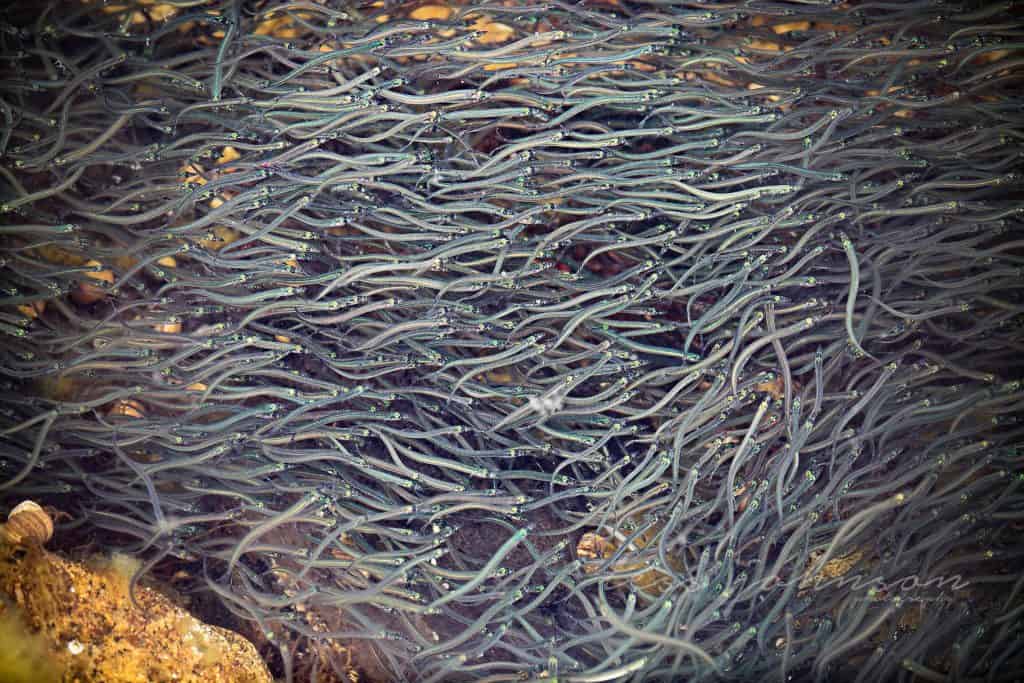
Until recently, I could not have told you the difference between an elver and one of Santa’s elves.
Now, thanks largely to excellent ongoing reporting by the CBC’s Paul Withers, I know more than I ever thought I would want to know about those slithery, slimy, ghostlike creatures. (Bless the public broadcaster — and our taxes that fund it — for developing subject-area specialist reporters like Withers who understand even endlessly complex, increasingly complicated and politicized industries like the Atlantic fishery.)
Elvers are nothing more — or less — than baby American eels before they grow longer than 10 centimetres. Elvers have been around since forever; otherwise, where would eels be?
Mature eels spawn in the Sargasso Sea in late winter and early spring. The Sargasso is an odd chunk of the Atlantic Ocean off Bermuda with no actual land borders but bounded on all sides by swirling ocean currents. Billions of the eels’ larval offspring drift and swim in the Gulf Stream heading west toward the US and Canadian coasts where they make their way into various streams, including many in the Maritimes, in the early spring. The little buggers eventually grow into young eels and spend from five to 20 years hanging out in what the scientists describe as “available habitats” before they become sexually mature and begin their return journey to the Sargasso Sea to spawn the next generation of little elvers, and then unceremoniously die. And so on. And so forth.
There is a whole industry in Asia based on growing elvers to adulthood in fish farms and then selling them to the Japanese, who prize them fried into a dish called kabayaki.
The problem is that there is now also a worldwide shortage of the little sliverers, thanks in part to overfishing and in part to a 2010 European ban designed to protect what the EU recognizes as an endangered fish.
For our purposes, you can skip lightly over most of that.
The important points are that there are still lots of little elvers slithering about in our waters but there is also a worldwide shortage of them.
Almost no one in Nova Scotia bothered them — or with them — until the early 1980s when Ottawa issued a few experimental licences to catch elvers in Maritime rivers and inlets. Apparently, however, no one was much interested in fishing for them at the time, so the licences weren’t renewed.
In the mid-1990s, interest picked up again, and annual landings began to top one tonne. In 2006, six experimental licences became permanent.
That same year, the Committee on the Status of Endangered Wildlife in Canada recommended that the American eel be listed as a “special concern,” a species at risk. The federal department of fisheries and oceans is still trying to decide how concerned we should be.
By the early 2020s, there were seven commercial licence holders, including the We’koqma’q First Nation in Cape Breton, for what had become an incredibly profitable but under-the-radar $40-million-a-year business.
Consider that a single kilogram of live elvers can fetch up to $5,000 in Asia, making it one of the most lucrative fishes in the world by weight.
Which is one reason things got complicated.
In response to what it also sort of recognizes as the declining numbers of eels, DFO cut the commercial quota in 2022 by 1,200 kg or 14 percent of the total allowable catch.
But then, as part of its broader reconciliation process with Indigenous communities — Ottawa is rightly committed to “increase First Nation participation in fisheries” to meet their treaty rights to fish — DFO reallocated half of that quota cut back to 10 Mi’kmaw and Maliseet communities.
The broader plan was supposed to include a buyback of that portion of the commercial quota given to First Nations. But when DFO couldn’t come to a financial arrangement with commercial fishers, it unilaterally cut their quota without compensating them at all.
This year Ottawa handed the entire 1,200 kg to First Nations in Nova Scotia and New Brunswick, again without compensating the previous licence holders.
Despite assurances from the former and current ministers of fisheries that Ottawa would reallocate quota using a willing-seller, willing-buyer process, DFO now claims it not only has the right to reallocate the quota on its own to increase Mi’kmaw participation in the fishery but also that it owes the former licence holders nothing.
Several commercial licence holders recently applied to the federal court seeking to set aside what it calls Ottawa’s “expropriation without compensation.”
It’s a mess, made messier because other fishery sectors may now be questioning Ottawa’s official commitment to “implementing rights-based fishing” while compensating commercial harvesters for the quota they’ll be losing.
Suggests Michel Samson, who represents one of the elver licence holders in the court challenge: “The message to commercial licence holders — whether it’s lobster, crab, halibut or anything else — you’re next.”
All of this has exacerbated already tense tensions among DFO, commercial fishers anxious to pursue their formerly-licenced livelihoods and Indigenous groups attempting to exercise their treaty rights.
We have already seen similar conflicts bubble over into violence in the lobster fishery.
Complicating that is the reality that harvesting elvers requires little more than what one US fisher described as “a five-gallon bucket, a dip net, and a Coleman lantern.” That fisher told Maine Public Media he had made more in a week fishing elver than he did in an entire season of traditional fishing.
That was 12 years ago.
Since then, ever-escalating live elver prices have spawned another industry: elver poaching by individuals and what appears to be organized groups. (Again, we know much of how this happened, thanks to a 2019 report by CBC investigative journalist Richard Cuthbertson.)
Given shrinking stocks and growing demand, poaching has become even more ubiquitous. Earlier this month, federal fisheries officers seized a shipment of elvers at the Halifax Stanfield Airport. The confiscated fish totalled only 25 kg but it was worth $112,000.
That same week, there was a violent assault over elvers on Shore Club Road in Hubbards. A group of seven individuals, some wearing balaclavas, several brandishing pipes, knives and Tasers, attacked a man, a woman and a youth on the street in a dispute over elvers.
According to Conservative MPs Rick Perkins and Clifford Small, “the Southern and Western Shores of Nova Scotia are seeing unprecedented levels of elver poaching in this year’s short season of March to June. Reports from fishing communities are that there are unlicensed commercial harvesters throughout the region from not only Nova Scotia, but from Maine, Quebec, and New Brunswick.”
DFO responded last week by simply shutting down the entire legal fishery for 45 days, effectively ending this year’s harvest.
That may — or may not — be good for the future of the eel population.
But it will certainly wreak havoc on the fishers — traditional commercial and Indigenous licence holders — who “abide by the law and fish in season.”
At the same time, the shutdown of legal fishing may encourage even more poaching.
A DFO spokesperson insists “fishery officers have been patrolling rivers, inspecting holding facilities and conducting surveillance and inspections at airports, border crossings and other exit points to ensure compliance with the regulations.”
But their total haul so far — 36 kg — suggests this is a battle the poachers are winning.
So let’s recap.
DFO decided not to follow the European Union’s ban on elver exports, thus putting the species at greater risk. Then it botched the reallocation of quota between commercial and Indigenous fishers. Then it failed to control poaching. Then it punished legal fishers — commercial and Indigenous — for trying to make a living. And is leaving the province’s waterways to the poachers, whose catch will not be recorded…
So far, so bad.
***
A version of this column originally appeared in the Halifax Examiner.
To read the latest column, please subscribe.




 STEPHEN KIMBER, a Professor of Journalism at the University of King's College in Halifax and co-founder of its MFA in Creative Nonfiction Program, is an award-winning writer, editor and broadcaster. He is the author of two novels and eight non-fiction books. Buy his books
STEPHEN KIMBER, a Professor of Journalism at the University of King's College in Halifax and co-founder of its MFA in Creative Nonfiction Program, is an award-winning writer, editor and broadcaster. He is the author of two novels and eight non-fiction books. Buy his books